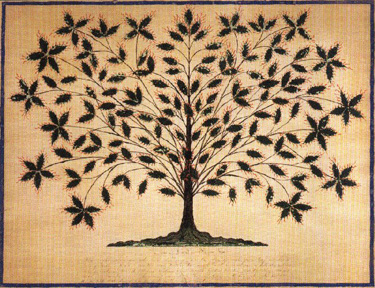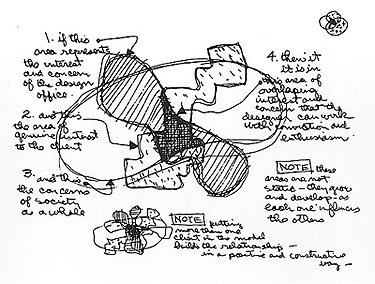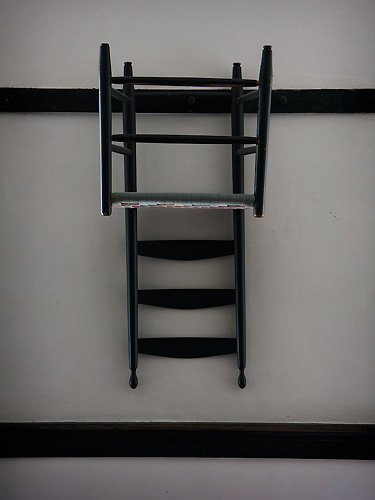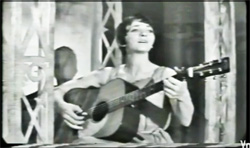Pictured above Charles and Ray Eames gaze at Shaker founder Mother Ann Lee(1736-1784), believed to be the Second Appearance of Christ in female form. Below Hannah Cohoon’s gift drawing “Tree of Light, or Blazing Tree” received in a vision in 1845.
 Two recent Eames sitings—“EAMES WORDS: The uncommon beauty of common things” at LA’s A + D Gallery and “EAMES: the architect and the painter” in cinema and DVD—focus with devotion on the words, work and work ethic of the 20th century design gods. Throughout art show and film one hears echoes of the voices of the Shaker religious fanatics of the previous centuries.
Two recent Eames sitings—“EAMES WORDS: The uncommon beauty of common things” at LA’s A + D Gallery and “EAMES: the architect and the painter” in cinema and DVD—focus with devotion on the words, work and work ethic of the 20th century design gods. Throughout art show and film one hears echoes of the voices of the Shaker religious fanatics of the previous centuries.
“EAMES WORDS,” part of the So-Cal-wide Pacific Standard Time art jamboree recognizes the Eames contribution to the West Coast way of seeing and thinking. Designed by Deborah Sussman, former Eames employee, the exhibit is organized entirely with quotes from Charles and Ray’s office. Their words and philosophy echo the joyfully severe wisdom of the sweet but fanatical Mother Ann Lee and the Shaker Religious Communes of 18th and 19th century America. When the exhibit is coupled with the simultaneous release of the film “EAMES: the architect and the painter”, the impression is compounded: the Shaker utopia/housewares-workshop and the Eames office/design-workshop (the self-dubbed “Eamery”) share a spare design ethos, a love of maxims, a serious work ethic, and a charismatic leadership dressed in eccentric garb.
“In the valley of love and delight ” American Shaker villages created furnishing for the New Heaven on Earth: “Hands to work, hearts to God.” (Mother Ann Lee). Their simple and spare furnishings and structures express the ephemeral quality of a spiritual existence: “The hands drop off but the work goes on.”(Eldress Bertha Lindsay). Notoriously celibate, yet fertile with homilies, the Shakers make clear that our comforts are spiritual, not physical. “Shakers … go about their duties in cheerful, happy helpful temper, feeling that “Labor is worship and prayer.” (Leonard, Shaker Manifesto 1871). “This manner of worship to the people of God is not empty, not carnal; but mighty through God, joyful as heaven and solemn as eternity.” (Benjamin Youngs, Testimony-1808-1856).
The Eames found joy in work without faith in the second coming, but instead with faith in design within constraints, that is to say in problem solving. Like Shaker text, second hand oral history from Eames family and staff delivers wisdom in mottos and maxims–“Charles would say”, “Ray used to say”, “they would love to say”, “there was an expression in the office”–
“Bring joy and vigor to whatever you do.”(Ray) ‘Take your pleasure seriously.“(Charles) “Life was fun was work was life.”(Sussman) And from staffer Parke Meek: “You know, … he just kept hammering away…. he made the work sort of a play thing.”
The Shakers knew how to have fun too. During the “cleansing gift” sweeping ritual of 1841 “the brethren would roar and howl … and stamp their feet with the word “curse” whenever they came upon an unclean spot.” (Andrews, The Gift to be Simple). Some like Nathaniel Hawthorne in (“Canterbury Pilgrims,”” The Shaker Bride”) and Adam Gopnick (“The Shining Tree of Life“) identify an obsessive compulsive mania for purity, order, cleanliness and sexual repression at the root of the Shaker joyous sublimation in work and their rigorous enthusiasm for clean lines, functionalism and commerce. So be it. The results speak for themselves.
Witness the visionary Shaker invention: the flat broom, now only $20.
“Simplicity is the embodiment of purity and unity.” “Beauty rests on utility.” “That is best which works best.” (Shaker maxims).
(Eames maxims): “Design is the appropriate combination of materials in order to solve a problem.” “We want to make the best for the most for the least.” “We don’t do art; we solve problems.” “Don’t let the blood show.”

Designed in 1942 by the Eames, the molded plywood leg splint, lightweight and inexpensive was mass-produced for the US Navy during World War II. (Now on ebay for $645.00, in pristine, un-used condition.)
“EAMES: the architect and the painter” creates an enjoyable portrait of a society of devoted workers, followers of Ray and definitely Charles. What holds ones interest in the movie are the talking heads, employees and colleagues, characters in their own right, in fond and teary-eyed reminisces. Charles was “Very charismatic.” “Very charismatic.” “And especially very charismatic to women.”(Sussman) “I was happy being exploited by a proper master,” Jeannine Oppewal. “It was 24/7, 365,” (Sussman) “He was the most important person in my life…. It was a delicious agony, like a temple for me.” (John Neuhart)
 With Shakers and Eames there is a directness in material and function, with ornament, if any, arising as a functional solution or material property. For the Shaker craftsmen there is emphasis on joinery; for the Eames, on connections. In the case of the DCM chair, the connections occur where wood meets metal with flexible rubber mounts, where the human body meets the molded seat and back, where the interests of office, client and society meet. “Eventually everything connects—people, ideas, objects, etc. … the quality of the connections is the key to quality per se.” Both had an interest in constraints.
With Shakers and Eames there is a directness in material and function, with ornament, if any, arising as a functional solution or material property. For the Shaker craftsmen there is emphasis on joinery; for the Eames, on connections. In the case of the DCM chair, the connections occur where wood meets metal with flexible rubber mounts, where the human body meets the molded seat and back, where the interests of office, client and society meet. “Eventually everything connects—people, ideas, objects, etc. … the quality of the connections is the key to quality per se.” Both had an interest in constraints.
 What we are left with as a lesson from Shakers and Eames is a functional elegance stemming from the clarity and joyful humanity of the problem solving seemingly unmuddied by ego or ornament. That the work is created by charismatic workaholics with righteous egos who dress funny is a different kind of lesson and makes for provocative reading, movies and gallery exhibits.
What we are left with as a lesson from Shakers and Eames is a functional elegance stemming from the clarity and joyful humanity of the problem solving seemingly unmuddied by ego or ornament. That the work is created by charismatic workaholics with righteous egos who dress funny is a different kind of lesson and makes for provocative reading, movies and gallery exhibits.
“God, the master workman, who has made the smallest insect with as much care as the mammoth elephant, sets us the example of good work. Imitation is the sincerest praise.” (Shaker Manifesto).
“The extent to which you have a design style is the extent to which you have not solved the problem.” “Innovate as a last resort.” (Eames mottoes).
Thanks to Otts World for the moving photo above of the inverted Shaker chair, in hanging position for thorough sweeping, and thanks to Judy Collins and her Simple Gifts.





Subject: Shakers and Eames…and Alice Coltrane
Mr. Hill,
Hello, my name is Cauleen Smith. I’m a filmmaker. I live in Chicago but I grew up in Sacramento in an Eichler house. But that’s not why I write. I enjoyed your article comparing The Eames to Mother Ann of the Shakers, and I wondered if this comparison was something that emerged from the shows and film you reviewed or was it your own brilliant deduction? I ask because of some research I’m doing on Alice Coltrane – who rather makes me think of Mother Ann in many respects – and wondered if you could point me to more texts or other things that make that same comparison? If not, well then I simply thank you for doing it and sending me down a very delightful rabbit hole of speculation – and more research.
Best Wishes,
Cauleen Smith
Cauleen–
Rabbit hole is the right word for my posts. The comparison of Eames and Mother Ann is all mine generated from a love of Eames’ potato chip DCM chair–metal legs not wood–and a love of Shaker furniture–and the shared philosophy of spareness and a kind of godly functionalism. The connection between Shakers, Eames and Thonet and Danish Modern seems obvious, but I was surprised too how far this mania could be taken and what notes it might strike in my own soul. Both the Eames and the Shakers put out a number of pamphlets and small books about their furniture and point of view that can be studied. Nathaniel Hawthorne has a story too. I’m going to put on some Alice Coltrane now–in San Francisco there is the church of John Coltrane(check out radio station KPOO’s John Coltrane hour on line where they replay the Love Supreme album every week with the occasional Alice. The Coltranes’ are definitely inspired and chatty but not as aesthetically spare and spiritually OCD as maybe Miles.
Let me know about the outcome of your research. Sounds fun.
James Hill
As President, Founder and sole member of the Jeannine Oppewal and Deborah Sussman Fan Club, I was blown away to meet Jeannine Oppewal in front of my neighbors’ house here in the Lower Haight. I pressed her to read my Eames/Mother Ann blog post and received this response. The Fan Club is hoping to hear from Deborah soon!
“Subject: Re: Gaga Neighbor
Not so far off, in a strange way. I once wrote that the reason why Herman Miller furniture loved Charles was because his design philosophy was the aesthetic equivalent of the Calvinist religious philosophy – spare, dedicated, etc. Herman Miller was owned by two Dutch Calvinist brothers – same religion as my father.”
To this the Fan Club would like to quote her further from the NY Times:
(see http://www.nytimes.com/2003/07/31/garden/at-home-with-jeannine-oppewall-thoroughbred-modern.html?pagewanted=all&src=pm)
“Someone might say the person who lives here is cold and hard,” she said evenly. “And I do have a minimal personality. I am not warm and fuzzy. I need aesthetic stimulation, not physical comfort. Friends say, ‘Jeannine, you sure have a big collection of uncomfortable furniture.’ But they think that furniture is to flop on or bounce on or put your feet on, and that’s not my feeling.
“One of the reasons I was so comfortable working with Charles Eames was that Charles was comfortable working for the Herman Miller furniture company, and that company was owned by a bunch of people from the Christian Reformed Church whose philosophy is that less is more, simple is better and cleanliness is next to godliness, and that, as it applies to the design world, was very appealing.”